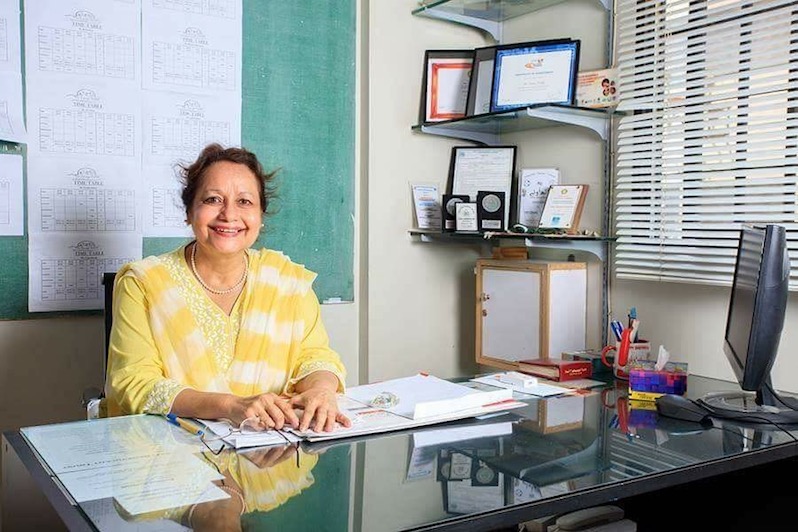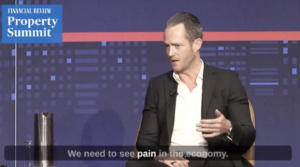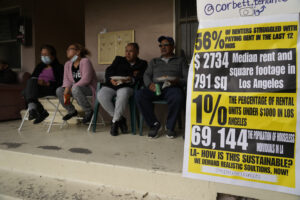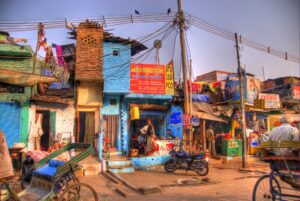Women Are at the Heart of Development in Pakistan
Those looking at Pakistan from the outside often miss stories about change-makers who do their country proud. The Garage School founder Shabina Mustafa at her desk in the educational center in Karachi, Pakistan. (The Garage School)
The Garage School founder Shabina Mustafa at her desk in the educational center in Karachi, Pakistan. (The Garage School)
Three years ago, when Truthdig invited me to write an article on “How the women of Pakistan cope” for its newly launched Global Voices Project, it was a challenge for me. I wished to show the readers a face of Pakistani women that does not generally figure in the global media. They are the women who do not in the normal course create a sensation. But in their quiet way they are the change-makers.
The relaunch of Truthdig offers me the opportunity to take another look at the situation of women in Pakistan. Has it changed?
First, let us redefine the dichotomy in the women’s situation in Pakistan in terms of their achievements. The two classes I spoke about in my earlier article still exist: We still have a small, privileged class of the haves, and there is also the huge, underprivileged class of the have-nots. The world fails to recognise Pakistani women through this perspective.
It must be remembered that this is the same country that produced Malala Yousafzai, who won the 2014 Nobel Peace Prize; the women’s cricket team that clinched the gold medal in the 2014 South Asian Games; Sharmeen Obaid-Chinoy, whose film “A Girl in the River” won her a second Oscar in 2016; Maria Toorpakai Wazir, who ranks 81st in the world in squash, and in 2017 was appointed to the International Olympic Committee’s Women in Sports Commission; and writer Kamila Shamsie, whose book “Home Fire” is included on the longlist for the 2017 Man Booker Prize. These women have been celebrated and have done us proud.
Yet despite accomplishments like these, Pakistani women generally get bad press because society is assessed on the basis of the average. The statistics present such a dismal picture, which is undoubtedly distressing. It is against this backdrop that we also need to evaluate the contribution of the change-makers. They give us hope.
The resilience that has sustained their efforts is remarkable. Experience has helped them refine their strategies. Since progress tends to happen in too scattered a fashion to make an impact, time is needed for results to show. It is, however, important that women join forces in some ways to ensure they do not regress in Pakistani society.
Let us look at the facts. Some international agencies maintain databases that are desegregated with regard to gender and enable comparisons of gender ratios nationally as well as internationally. The two most commonly used indices are the World Economic Forum’s Gender Gap Index (GGI) and the United Nations Development Program’s Gender Inequality Index (GII), which is a part of the Human Development Report. Pakistan, unsurprisingly, figures low in the rankings of both.
According to the GGI, Pakistan stands at the 143rd position among 144 countries listed. Since this index focuses more on economic status and related areas, it reflects the poor opportunity the women of Pakistan have to improve their lives. These areas are economic and participation opportunity (ranking: 143) and educational attainment (ranking: 135).
Similarly, in the 2015 GII, the country fares no better. Of 158 states ranked, Pakistan is 130th. Only 26.5 percent of Pakistani women have some secondary education, and only 24.3 percent are in the labor force.
How do all these statistics translate into the situation on the ground? Since they are not empowered—neither economically nor politically nor educationally—women by and large lack confidence and occupy a low status in society. They also commonly do not possess the capacity and awareness to fend for themselves. As a result, they are denied their basic rights, are the victims of social prejudice, are discriminated against and suffer the worst kind of brutalities. In fact, the incidence of violence against women has been on the rise and is making a splash in the national media. But to obtain authentic figures, ones that are quoted identically by several sources, is impossible.
According to the World Economic Forum, nearly 5,000 women are killed every year in some form of violence in Pakistan, and thousands of others are maimed or injured. The report from the Human Rights Commission of Pakistan for 2015 was equally horrendous: 939 women were victims of sexual violence, 279 suffered domestic violence, 143 were victims of acid attacks and burning and 833 were kidnapped. The year also saw 777 cases of suicide or attempted suicide by women.
This high rate of violence needs to be seen in its sociological and historical context. Every society has undergone a similarly bleak phase in its history. Progress has been uneven worldwide, and the gender disparity persists.
Too many factors have made it hard for Pakistani women to get out of our dark ages. Developing nations have been handicapped by the long period of colonization that arrested the growth and evolution of societies in the colonized regions. When their social, economic and political development was resumed in the post-decolonization period, several complicating factors had emerged. There was the radically transformed socioeconomic and political structure at the global level and within the decolonized states themselves to contend with. Above all, technology introduced a ubiquitous media that penetrated every corner of the world with control vested in the powerful and the rich. That would explain why the emancipation of women in various countries has been so uneven. Besides, human development is a composite process. Every dimension of life has to develop evenly and in tandem with one another. The emancipation of women calls for the development of their education and health care, the generation of employment, the inclusion of women in the workforce and the formulation of laws to protect the legitimate gains that are made. Above all, it requires a change of mindset on the part of both men and women in a society with strong patriarchal traditions.
This is a complex and symbiotic process that has been complicated by the factors mentioned above. It is against this backdrop that I write about the twinkling stars in Pakistan’s dark scenario who are working so hard to change the lives of women in the country. Here I will take up two examples. Their strategies have marked similarities but there are basic differences too, as the conditions in which they operate are so dissimilar.
One is Shabina Mustafa, the founder of The Garage School in the heart of Karachi, Pakistan’s port city and biggest urban center with a population of 20 million. The school was set up under the aegis of the Safi Benevolent Trust. The second is Naween Mangi, who set up the Ali Hasan Mangi Memorial Trust in Khairo Dero, a small village in the Larkana district of Sindh province.
Mustafa started her project in 1999 with a handful of students. Today, 501 are enrolled. It was basically intended to teach girls to empower themselves and help them improve their lives. The school has grown over the last 18 years from the garage where it was born to three campuses in a squatters’ colony to accommodate the growing number of students, who range in age from 4 to 18.
Mustafa has calculatedly adopted a holistic policy vis-a-vis the children who attend her school, the majority of whom are girls. She very clearly understands that a child’s education and mental and personality growth depend heavily on her health, nourishment, exposure to a wholesome environment and good living conditions that influence a growing child. A physician is available in school to provide treatment to any child or even her family members in times of illness. This could sometimes necessitate a visit to the hospital. Additionally, all children are provided vitamin pills and sustenance in the form of snacks and milk to keep them healthy.
The families are also taken care of and on special occasions are provided food rations. The latest addition in this regard is the water filter Mustafa has installed to provide pure drinking water for a nominal sum.
For Mustafa, education is contextualized basically in the enhancement of human development. This comprises a large component of curricular instruction and recreation to prepare children for a productive life by supplementing their knowledge and technical and social skills. This, she hopes, will empower the children and their families—which, in turn, will facilitate their moving out of poverty.
A focus on enhancing female capacities is another important element in Mustafa’s program, which in part explains why women are given so much emphasis. The ratio of girls and boys is preponderantly in favor of the former; there are 271 girls as compared to 230 boys in the school. Of the 45 staff members, 31 are female.
While operating in urban settings offers advantages to The Garage School, it faces serious problems as well. The major issue is that of accommodation in a city bursting at the seams. The school is crowded into small premises in a noisy commercial area with the sword of eviction constantly hanging over it. Strangely, the authorities have not tried to help by providing land for the school in an area closer to where the children live.
A study I conducted a few months ago yielded shocking results about the state’s negligence of the educational needs of the poor. A squatter settlement on the edge of an elitist housing society is home to about 25,000 school-age children. The 16 neighborhood schools can provide education to at best 5,000 children. Where should the rest go?
This is a major problem for Mustafa—her need for space. She terms it “one of the biggest challenges” for schools like hers. She has been receiving notices from the authorities to vacate the building where the school is located. “I cannot close down the school while I look for a place to shift hundreds of children there,” she says. “Besides, it has to be somewhere close. How can the kids walk to a far-fetched place? We are not even given any land in this area where we can construct our own school.”
Cities pose other problems too. For Mustafa, it is a battle against the growing forces of commercialization which seek cheap labor even though child labor is prohibited by law. “Our children are barely halfway through school and are beginning to acquire some proficiency in reading and writing when they start getting job offers from the shopping malls for menial jobs,” Mustafa says. “They lose interest in their studies and at the first opportunity become school dropouts. I want them to complete school, but it is impossible to hold them back. After all, they need money.”
Her next challenge is to track down skilled teachers. Although she offers professional training to teachers, she has failed to motivate them to attend. That is the problem with education in Pakistan—it does not offer any motivation. A girl with primary schooling would earn as much as someone who passes her graduation exam.
Mangi’s approach is equally holistic. Since she is based in a rural area that is more underdeveloped and impoverished, her challenge is of a different nature. Poverty is the biggest problem. But her goals are similar: She wants to bring about a “silent revolution” in the lives of the 9,000 or so inhabitants of Khairo Dero and lead them out of poverty. Though education and the uplift of women also play a central role in her scheme of things, she has to address many more dimensions of people’s lives to help them survive.
“Women are at the heart of how our model of development works,” Mangi observes. “It is women who come to our community center and apply for facilities they need—a house, a toilet, a gas connection, school admission, a scholarship for their child, solar power, a loan, medical help for anyone in the family and so on. Our list of applicants and beneficiaries goes by women, not men, because they are the ones whose lives are most affected by the lack of basic facilities, they are also the ones with the biggest stakes. Moreover, the ideas for our most successful projects have come from women.”
As a result, there is a lot of emphasis on gender equity, and of the 700 children enrolled in school in Khairo Dero, half are girls. Of the 45 indoor office workers and teachers, 25 are women.
Thus, what we see is development through women’s empowerment.
Mangi’s number-one challenge in creating a model village is, she says, “getting people to take interest and ownership of projects that benefit the entire community on a communal level, such as cleaning the streets, cleaning the sewerage drains and so on.”
The second problem Mangi identifies is the lack of skilled workers, especially teachers and administrators. That affects the quality of education provided and the smooth day-to-day running of the project. Finding good teachers or training them is a universal problem for educators in Pakistan.
Most of these challenges Mustafa and Mangi are grappling with are not unexpected. They are also not new, having been born from the centuries of socioeconomic stagnation that has robbed people of the motivation they need to pull themselves out of despair. Still, Pakistan claims thousands of mobilizers like Mustafa and Mangi who inspire the people they work with. If the government were only to extend a helping hand, the pace of development would surely be accelerated.
Your support matters…Independent journalism is under threat and overshadowed by heavily funded mainstream media.
You can help level the playing field. Become a member.
Your tax-deductible contribution keeps us digging beneath the headlines to give you thought-provoking, investigative reporting and analysis that unearths what's really happening- without compromise.
Give today to support our courageous, independent journalists.






You need to be a supporter to comment.
There are currently no responses to this article.
Be the first to respond.